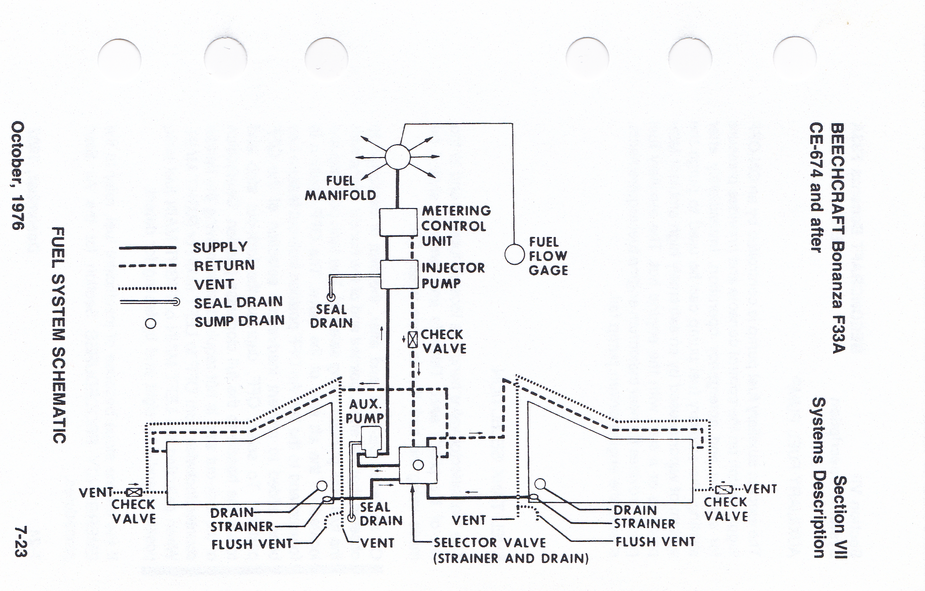I always thought that the fuel returned from the engine goes back to tank that feeds the engine, and when you switch tanks, the tank to which fuel returns is switched as well. This way there is no risk of overfilling or pressurising a tank.
Some years ago I rented a BE33 from a club where I was told I always needed to start by selecting the left tank because fuel returned from the engine was always routed there.
I never found any supporting documentation for this claim, and since I felt it was safer to do so, I went along with it.
Any ideas of what is the case? Are there planes on which fuel is returned to the same tank all the time regardless of the position of the fuel selector?
Aviathor wrote:
I always thought that the fuel returned from the engine goes back to tank that feeds the engine, and when you switch tanks, the tank to which fuel returns is switched as well.
On all aircraft that I have flown so far, it is the opposite. The return line always goes to the main tank (in case of multi engine aircraft to the main tank on the side of the appropriate engine) no matter what tank is selected to supply the engine. This has caught many pilots who thought running on auxiliary tanks or crossfeeding early to balance tanks might be a good idea… The fuel dumped overboard that way must be sufficient for a dozen moon rockets!
The return line always goes to the main tank (in case of multi engine aircraft to the main tank on the side of the appropriate engine) no matter what tank is selected to supply the engine.
I was thinking about SEP with a simple fuel system – auxiliary tanks. Be33 w/o tip tanks, PA28 etc. If the engine is fed from the right main tank, return fuel goes to the right main tank. And if it is fed from the left main tank, return fuel is going to the left main tank. No?
This is engine specific too because e.g. Lycomings don’t have a return line. The carb versions don’t need it, and the injected versions use a “constant pressure” pump and the fuel servo lets in what it needs.
This would also do interesting stuff with a fuel totaliser. How is that installed if there is a tank return? You must then have two transducers, and subtract one from the other.
This very short thread seems to answer the above question. They put the transducer into the feed to the fuel distributor “spider”.
The vintage V-tail Bonanzas definitely had a fuel return line into the left main tank only, and when operating at low power (especially taxiing) from the other tanks, fuel was transferred at a rather high rate. I don’t remember exactly how quickly, but I believe it was around half the cruise fuel flow.
Even when flying int the cruise, some fuel was returned to the left tank, and you had to fly off a bit from hat tank before switching to any other.
With five tanks in total with around one hour cruise in each (ok, six as aux was two tanks, but could only be selected together), only two of which available for take-off and landing, the overall tactic was this:
If you need th use the tip tanks, then it.s getting complicated if you want to keep the aircraft balanced…
Cobalt wrote:
The vintage V-tail Bonanzas definitely had a fuel return line into the left main tank only
That’s exactly what I was looking for. I am a little surprised this exists. It demonstrates how important it is to understand the fuel system of the airplane(s) you fly.
In the meantime I managed to dig up the F33A POH, which even seems to cover this particular S/N, and find the fuel system schematics.

Clearly, on the F33A, the fuel returns to the same tank it was fed from.
Peter wrote:
This would also do interesting stuff with a fuel totaliser. How is that installed if there is a tank return?
Could it be installed between the metering unit and the fuel distribution spider?
Peter wrote:
This is engine specific too because e.g. Lycomings don’t have a return line. The carb versions don’t need it, and the injected versions use a “constant pressure” pump and the fuel servo lets in what it needs.
Really? The fuel system diagram for my club’s C172S with a fuel-injected Lycoming engine shows a return line. The POH also has section explaining the fuel return.
Aviathor wrote:
I was thinking about SEP with a simple fuel system – auxiliary tanks. Be33 w/o tip tanks, PA28 etc. If the engine is fed from the right main tank, return fuel goes to the right main tank. And if it is fed from the left main tank, return fuel is going to the left main tank. No?
I don’t see why the fuel system should be made more complicated by having a double fuel selector valve — one for the fuel supply and one for the return fuel.
Our C172S that I mentioned above has a “Reservoir tank” after the fuel selector and the return fuel is fed to that tank.
(The reservoir tank has its own drain — one of the reasons why this 172 model has a total of 13 drain points!!)
The Robin HR100 with 4 tanks (L/R, inner/outer, >100L each) and a Conti IO360 returns fuel only to Left Inner tank. That one this be used for t/o and ldg as well as for some time after filling it…
And yes, balancing the plane took some scheduled switching.
(Didnt have it long enough to make a plan myself)
Interesting, AA. What engine and what fuel servo does the C172S use?